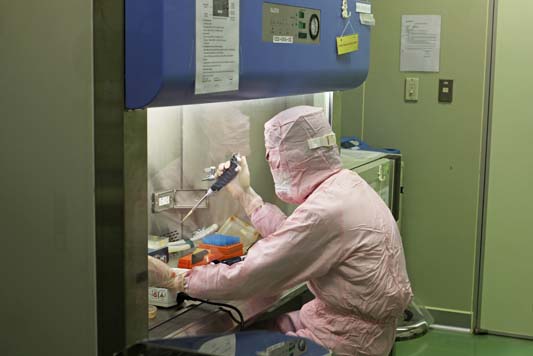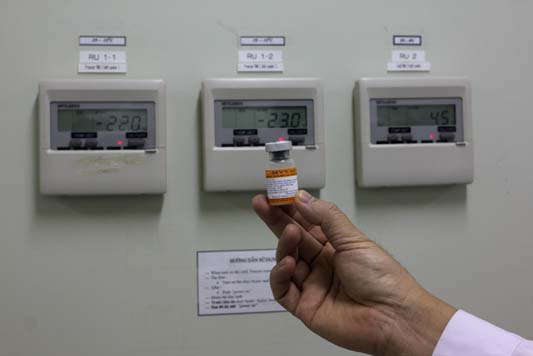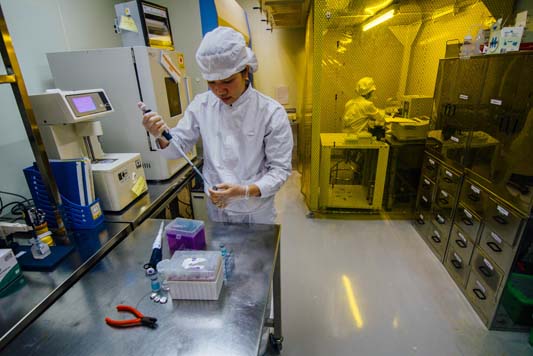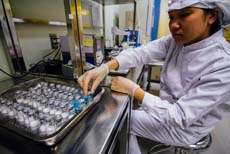When Nguyen Dang Hien, MD Phd, graduated from Hanoi Medical University in 1989, his first job was with Vietnam’s Centre for Research and Production of Vaccines and Biology (POLYVAC). He staffed the production line, working on quality control for the polio vaccine.
He looks back at the year 2000, when the World Health Organization (WHO) declared Vietnam polio-free, as a career highlight.
“We are very proud of polio eradication,” Dr. Nguyen says in an interview at POLYVAC’s boardroom. “It proves the safety and efficacy of the vaccines we produce not just in the fight against polio, but in our work against other diseases as well.”
Dr. Nguyen is now the director of POLYVAC, one of four state-owned vaccine production companies in Vietnam. POLYVAC has been prequalified by WHO and is at the vanguard of the country’s efforts to improve the quality and targeting of its products.
A good example can be found in the company’s labs, where scientists are developing a measles-rubella vaccine. POLYVAC’s measles vaccine is effective, and has reduced the incidence of the disease by 400 percent. But a resurgence of rubella—a viral infection also known as German measles—has generated a new immunization need for Vietnam’s Health Ministry to address.

In response, the Ministry of Health began purchasing and distributing a measles-rubella vaccine that it imports from a company in India. Plans are in place, however, to switch to a domestically produced solution.
“Local vaccine production, Dr. Nguyen said, “is much less expensive than importing the products. The cost of producing one dose of the rotavirus vaccine, for example, is one third the price of importing a dose. For the polio vaccine, we produce approximately 10 million doses at a cost of about 20 billion Vietnamese Dong. But if we imported the vaccine from another country, we would need to spend 40 billion.”

In 2013 POLYVAC began working on developing its own version of a measles-rubella vaccine. In a WHO-qualified laboratory that rigorously controls the quality of medicines, technicians strictly follow WHO guidelines for norms and standards in vaccines. In fact, the many reference manuals provided by WHO have their own room in the lab, and all workers can access the materials when needed.
Vietnam’s Expanded Programme on Immunization includes 11 vaccines now, and all but one of them are produced domestically. The government provides the vaccines free of charge to all children under the age of six, with efforts primarily focused around a national day of immunization.

“Vietnam faces many challenges as a rapidly developing middle income country,” says Socorro Escalante, MD, WHO’s technical officer and medicines policy advisor in Vietnam. “For local pharmaceutical production to be more effective, we need to shift the industry paradigm to ensure that the products they manufacture address priority illnesses and diseases in the country and to also ensure that they are available everywhere they are needed.”
Dr. Nguyen notes that POLYVAC and the other Vietnamese vaccine manufacturers are working with WHO so that the products can be prequalified for procurement in neighbouring countries. Vietnam’s typhoid vaccine, produced at another facility, has already been cleared for procurement and its BCG vaccine, generally used to prevent tuberculosis, will soon be cleared as well.

“Because the birthrate increases every day in our country—it’s now about 1.5 to 1.7 million new births annually—and because we are in a tropical climate with very humid weather, providing our own vaccines for the population is an important goal for the health sector,” he added.
“Being self-sufficient is a very big achievement for Vietnam,” he concluded. “It shows a scientific development pathway for Vietnam when you compare us to other countries, especially other developing countries.”
